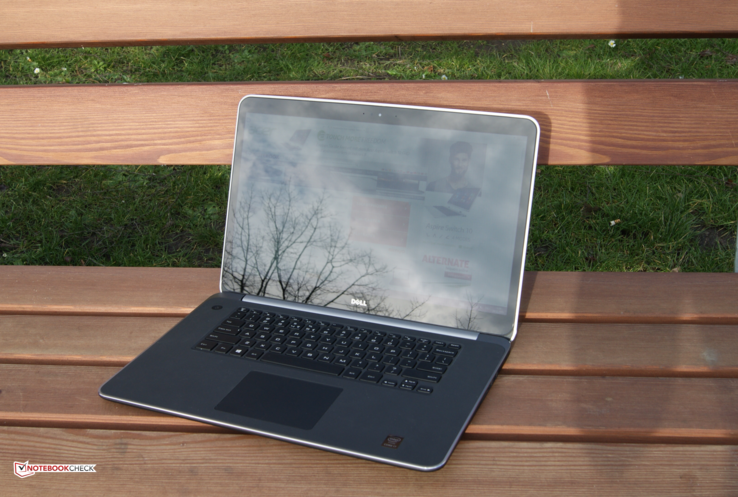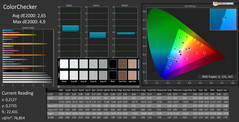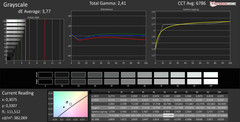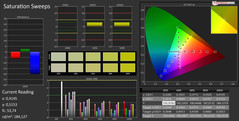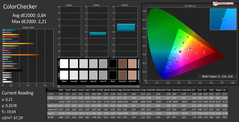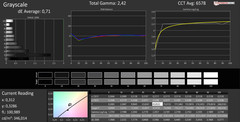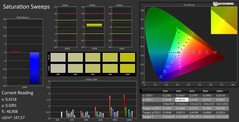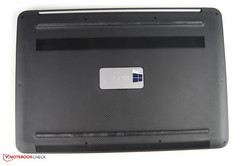Dell XPS 15 Notebook Review

For the original German review, see here.
What's a QHD+ display with a resolution of 3200x1800 pixels if there's an even higher rung on the "sharpness" ladder? Dell decided to increase the resolution yet again to over 2.5 million pixels and outfitted the Dell XPS 15 with a 4K UHD display with a resolution of 3840x2160. But that wasn't enough of an upgrade: Our test device is also equipped with a powerful Intel Core i7-4712 HQ CPU, in place of its predecessor's Intel Core i7-4702HQ. The size of the memory, however, remains the same. The price has fallen since our first review and is now hovering around 1850 Euros (~$1968) in retail stores. In this review, we'll focus on the more important updates to the notebook; more information on the unchanged components (case, input devices, connections) can be found in our earlier review of the Dell XPS 15 (Late 2013).
Display
Dell outfitted their new XPS 15 with a razor-sharp 4K-UHD display in the 16:9 format. Not only does the display offer more in terms of pixels - its brightness is higher too. An average of 365 cd/m² ensures that little reflections here and there aren't bothersome enough to disrupt the user's work-flow. As a result of the increased brightness, the black value has also risen from 0.21 cd/m² to 0.28 cd/m², which has consequences in the realm of contrast. Even so, the screen's black and color tones are rich. Thanks to the high-quality IPS panel, the display content looks correct even from sharp angles. Even in battery mode, the panel can reach high brightness levels of up to 349 cd/m². The problem remains, however, that some programs are unable to cope with the high resolution and can only be rendered very small or in a pixelated state.
| |||||||||||||||||||||||||
Brightness Distribution: 87 %
Center on Battery: 349 cd/m²
Contrast: 1238:1 (Black: 0.282 cd/m²)
ΔE ColorChecker Calman: 2.65 | ∀{0.5-29.43 Ø4.78}
ΔE Greyscale Calman: 3.77 | ∀{0.09-98 Ø5}
96.1% sRGB (Argyll 1.6.3 3D)
61.02% AdobeRGB 1998 (Argyll 1.6.3 3D)
66.9% AdobeRGB 1998 (Argyll 3D)
96.1% sRGB (Argyll 3D)
64.9% Display P3 (Argyll 3D)
Gamma: 2.41
CCT: 6786 K
The CalMAN measurements corroborate our positive subjective impression of the display. Directly out of the factory, the average DeltaE deviation from the sRGB reference color space comes to a mere 2.65, and just 3.77 for the grayscale. After a calibration, these DeltaE deviations drop to 0.84 for colors and 0.71 for the grayscale.
| Dell XPS 15 (9530-0538) GeForce GT 750M, 4712HQ, Lite-On LMT-512L9M | Dell XPS 15 (Late 2013) GeForce GT 750M, 4702HQ, Samsung SSD SM841 512GB | Apple MacBook Pro Retina 15 inch 2013-10 GeForce GT 750M, 4850HQ, Apple SSD SM0512F | Asus NX500JK-DR018H GeForce GTX 850M, 4712HQ, Samsung SSD XP941 MZHPU256HCGL | |
|---|---|---|---|---|
| Display | 7% | |||
| Display P3 Coverage (%) | 64.9 | 72.6 12% | ||
| sRGB Coverage (%) | 96.1 | 96.1 0% | ||
| AdobeRGB 1998 Coverage (%) | 66.9 | 72.9 9% | ||
| Screen | -34% | 1% | -7% | |
| Brightness middle (cd/m²) | 349 | 349 0% | 332 -5% | 309 -11% |
| Brightness (cd/m²) | 365 | 322 -12% | 302 -17% | 290 -21% |
| Brightness Distribution (%) | 87 | 83 -5% | 83 -5% | 86 -1% |
| Black Level * (cd/m²) | 0.282 | 0.21 26% | 0.3326 -18% | 0.26 8% |
| Contrast (:1) | 1238 | 1662 34% | 998 -19% | 1188 -4% |
| Colorchecker dE 2000 * | 2.65 | 8.27 -212% | 1.95 26% | 4.69 -77% |
| Greyscale dE 2000 * | 3.77 | 7.99 -112% | 2.11 44% | 3.35 11% |
| Gamma | 2.41 91% | 3.42 64% | 2.34 94% | 2.33 94% |
| CCT | 6786 96% | 8117 80% | 6489 100% | 6400 102% |
| Color Space (Percent of AdobeRGB 1998) (%) | 61.02 | 69.08 13% | 60.6 -1% | 83 36% |
| Color Space (Percent of sRGB) (%) | 96.1 | |||
| Total Average (Program / Settings) | -14% /
-22% | 1% /
1% | -7% /
-7% |
* ... smaller is better
Performance
The hardware at work in the Dell XPS 15 reacts to commands very quickly. One of the device's highlights is a high-end Intel Core i7-4712HQ quad-core processor. Dell chose to stick with the predecessor's 16 GB of dual-channel DDR3 memory. As in the 2013 model, an Nvidia GeForce GT 750M takes care of graphics performance. Unfortunately, Dell has yet to indicate a future option to upgrade to a GPU from the newer Nvidia GeForce 800 or soon-to-be-released 900 lines. In its current configuration, the test device is a high-midrange model predestined for use in the multimedia arena, especially for image, graphics and video editing.
Processor
The Dell XPS 15 is equipped with a powerful quad-core processor from Intel. In our current model, the chip runs 100 MHz faster than its predecessor's. That means the Intel Core i7-4712HQ has a base clock rate of 2.3 GHz. In turbo mode, the clock frequency can rise to up to 3.3 GHz. Unlike other HQ models from the i7 line, the "2" in this processor's name indicates a low TDP. In our case, according to the manufacturer, the chip generates up to 37 W of heat - 10 W less than other HQ processors. The Cinebench R11.5 benchmark should reveal the efficacy of the 100 MHz increase in clock frequency. The difference between the CPU at work in our test device and the chip in the 2013 model proves to be almost imperceptible - the new notebook only scored 2% higher than the older model in the multi-core test. The CPU ran at a constant 3 GHz during the Cinebench test, which means that the computer is unable to take full advantage of the processor's turbo mode under load. In battery mode, the CPU frequency slowly rose from 800 MHz to 2.9 GHz, which explains the loss of about 40 points in the end result of the Cinebench R15 benchmark. Without a power outlet nearby, the computer will have less CPU performance at its command.
| Cinebench R11.5 | |
| CPU Multi 64Bit (sort by value) | |
| Dell XPS 15 (9530-0538) | |
| Dell XPS 15 (Late 2013) | |
| CPU Single 64Bit (sort by value) | |
| Dell XPS 15 (9530-0538) | |
| Dell XPS 15 (Late 2013) | |
| Cinebench R10 | |
| Rendering Multiple CPUs 64Bit (sort by value) | |
| Dell XPS 15 (9530-0538) | |
| Dell XPS 15 (Late 2013) | |
| Rendering Single CPUs 64Bit (sort by value) | |
| Dell XPS 15 (9530-0538) | |
| Dell XPS 15 (Late 2013) | |
System Performance
Short reaction times make working more of a breeze. Thanks to the fast storage medium and dual-channel RAM, our interaction with the system was always quick and smooth. The accuracy of our subjective impression was confirmed by PCMark 7, although the results are a bit perplexing at first glance. The hardware Dell chose to install in our test device is slightly more powerful than the components at work in the predecessor model, but the new notebook's results are considerably worse than the previous machine's. This could be a first clue that the change of SSD manufacturer wasn't necessarily a positive one.
| Dell XPS 15 (9530-0538) GeForce GT 750M, 4712HQ, Lite-On LMT-512L9M | Dell XPS 15 (Late 2013) GeForce GT 750M, 4702HQ, Samsung SSD SM841 512GB | Apple MacBook Pro Retina 15 inch 2013-10 GeForce GT 750M, 4850HQ, Apple SSD SM0512F | Asus NX500JK-DR018H GeForce GTX 850M, 4712HQ, Samsung SSD XP941 MZHPU256HCGL | |
|---|---|---|---|---|
| PCMark 7 | 19% | 17% | 2% | |
| Score (Points) | 5549 | 5937 7% | 5842 5% | 5565 0% |
| Lightweight (Points) | 3555 | 3678 3% | 3748 5% | |
| Productivity (Points) | 2782 | 2878 3% | 5357 93% | 2911 5% |
| Entertainment (Points) | 4000 | 10503 163% | 4674 17% | 3907 -2% |
| Creativity (Points) | 10028 | 4481 -55% | 9329 -7% | 10264 2% |
| Computation (Points) | 17929 | 19543 9% | 10885 -39% | 17559 -2% |
| System Storage (Points) | 5392 | 5562 3% | 7136 32% | 5608 4% |
| PCMark 7 Score | 5549 points | |
Help | ||
Storage Devices
Compared to the storage device at work in the predecessor model, Dell "only" switched manufacturers - the amount and type of storage remain the same. Instead of a storage medium from Samsung, our XPS is equipped with a solution from LiteOn-IT. The AS SSD benchmark's analysis reveals that the new SSD's sequential read and write rates are somewhat slower, but its results in the more important 4k tests are stronger. Of the drive's 512 GB, the Windows partition has 457 GB at its command. A further 20 GB belongs to the recovery partition.
Graphics Card
The Dell XPS 15 is still outfitted with the Nvidia GeForce GT 750M, first introduced at the beginning of 2013. Due to the fact that the current configuration's more powerful CPU has very little effect on the notebook's graphics performance, more information regarding the GPU's performance reserves can be gleaned from our review of the Dell XPS 15 (Late 2013). Out of the benchmark tests we performed, only 3DMark Cloud Gate showed an inexplicable, substantial improvement of 22%. For further comparisons and benchmarks, see our benchmark list of notebook graphics cards.
| 3DMark | |
| 1280x720 Cloud Gate Standard Score (sort by value) | |
| Dell XPS 15 (9530-0538) | |
| Dell XPS 15 (Late 2013) | |
| 1920x1080 Fire Strike Score (sort by value) | |
| Dell XPS 15 (9530-0538) | |
| Dell XPS 15 (Late 2013) | |
| 1280x720 Ice Storm Standard Score (sort by value) | |
| Dell XPS 15 (9530-0538) | |
| Dell XPS 15 (Late 2013) | |
| 3DMark 11 - 1280x720 Performance (sort by value) | |
| Dell XPS 15 (9530-0538) | |
| Dell XPS 15 (Late 2013) | |
| 3DMark 11 Performance | 2971 points | |
| 3DMark Ice Storm Standard Score | 70949 points | |
| 3DMark Cloud Gate Standard Score | 10521 points | |
| 3DMark Fire Strike Score | 2049 points | |
Help | ||
Gaming Performance
Unfortunately for gamers, even somewhat older games can only be enjoyed at low or medium graphics settings. Additionally, the notebook is only able to reach fluid frame rates if the display resolution is dramatically reduced. In the game BioShock Infinite (2013), we see that the stronger CPU doesn't have a significant effect on performance. For current games, the GT 750M GPU at work in our test device plainly proves to be too weak. Even though the XPS 15 clearly isn't primarily designed for gaming, we would expect a premium notebook - which Dell obviously intends for the XPS 15 to be - to have up-to-date hardware for maximum graphics performance.
| BioShock Infinite | |
| 1920x1080 Ultra Preset, DX11 (DDOF) (sort by value) | |
| Dell XPS 15 (9530-0538) | |
| Dell XPS 15 (Late 2013) | |
| 1366x768 High Preset (sort by value) | |
| Dell XPS 15 (9530-0538) | |
| Dell XPS 15 (Late 2013) | |
| low | med. | high | ultra | |
|---|---|---|---|---|
| BioShock Infinite (2013) | 121.7 | 77.3 | 60 | 22.04 |
Emissions & Energy Management
The XPS 15's fans perform their task discreetly until the system is under stress. In idle mode, we only heard subtle sounds of up to 32 dB(A). Not even under load does the system generate a disruptive level of noise. The fans run at a distinctly audible 45 dB(A) and whir more loudly than in our test device's predecessor, but the dull sound of the fans isn't bothersome. We did notice in our tests, however, that the fans occasionally grew noticeably louder for no apparent reason. It's not clear whether some specific piece of software in our test device is at fault for this.
Noise level
| Idle |
| 29.6 / 31.6 / 31.6 dB(A) |
| Load |
| 45.4 / 45.4 dB(A) |
 | ||
30 dB silent 40 dB(A) audible 50 dB(A) loud |
||
min: | ||
Temperature
The combination of the notebook's thin build and powerful hardware components has an unmistakable effect on the device's case temperatures. Advantageously, however, the rubberized surface of the keyboard proves to be heat resistant.
In idle mode, we measured temperatures of up to 38 °C (100.4 °F) on the top side in the keyboard/palm rest area. This amount of heat isn't bothersome. However, at 44 °C (111.2 °F) on the bottom side of the case, you can feel the warmth emitted by the notebook on your lap. Under load (stress test), the temperatures increase substantially: We measured a temperature of almost 65 °C (149 °F) in a hotspot on the underside of the case towards the back, which presumably reveals the position of the CPU. At around 30 °C (86 °F), the palm rests remain comfortably cool, but the keyboard reaches a much too warm 52 °C (125.6 °F) in the middle towards the back. We were able to give the notebook's predecessor an all-clear in our tests in this discipline, as even games like Battlefield 4 only warmed up the XPS to 50-55 °C (122-131 °F). The power supply can heat up to 49 °C (120.2 °F), so leaving it under a blanket would be dangerous.
In our stress test, we run Prime95 and Furmark simultaneously to analyze how the machine behaves as it heats up inside. Within the first few minutes, the clock rate already starts to drop continuously and lingers between 2.5 and 2.6 GHz. After more than 40 minutes, the core temperatures rise to over 95 °C (203 °F) and the CPU starts to throttle. At the end of the stress test, we determine how much performance power the notebook has at its command by starting 3DMark 11. With a score of 2969, the system performs just as well in this state as it did after a cold boot.
(-) The maximum temperature on the upper side is 51.8 °C / 125 F, compared to the average of 36.9 °C / 98 F, ranging from 21.1 to 71 °C for the class Multimedia.
(-) The bottom heats up to a maximum of 64.6 °C / 148 F, compared to the average of 39.2 °C / 103 F
(±) In idle usage, the average temperature for the upper side is 33.1 °C / 92 F, compared to the device average of 31.3 °C / 88 F.
(+) The palmrests and touchpad are cooler than skin temperature with a maximum of 30.8 °C / 87.4 F and are therefore cool to the touch.
(-) The average temperature of the palmrest area of similar devices was 28.7 °C / 83.7 F (-2.1 °C / -3.7 F).
Power Consumption
Even with its brightness level set to minimum and its communications modules deactivated, at a power consumption rate of 14.6 W, our test device is rather thirsty. The notebook's predecessor was more frugal, only using 10-17.4 W in idle mode. The increase in power usage may be traceable to the 4K display.
The difference between the results in our medium and maximum load tests is especially striking. Under medium load, the XPS requires between 90 W and 96 W. When we start our stress test using Prime95 and Furmark, however, the machine only needs about 86 W. This can be traced to the aforementioned CPU throttling.
| Off / Standby | |
| Idle | |
| Load |
|
Key:
min: | |
Battery Life
Dell once again chose to equip their XPS 15 with a relatively large 91 Wh battery with 6-cells. The notebook's energy consumption rates lead one to surmise that our current test device will run out of steam faster than its predecessor. We are, however, unable to make a perfect comparison, as our WLAN test has been revised since the 2013 review. After a little over 5 hours, the new XPS needs to be plugged back into the wall. Unfortunately, though the XPS is designed as a work and multimedia device, it won't last through a full workday without a connection to a power outlet. The predecessor kept chugging along for almost 9 hours in our test, though the test parameters were slightly different.
| Battery Runtime - WiFi Websurfing (sort by value) | |
| Dell XPS 15 (9530-0538) | |
Pros
Cons
Verdict
The Dell XPS 15 is and remains a showpiece. When it comes to the notebook's case and input devices, Dell sets the bar high, but the main focus of attention here is the new 4K display. The resolution isn't the display's only impressive quality - its relatively high average brightness and its correct color and grayscale representation are also exemplary. Even though the new notebook's contrast is lower than that of its predecessor, thanks in part to its fast hardware components, working on the Dell XPS 15 is just plain fun. Dell has once again created a well-rounded multimedia package - though at 1850 Euros (~$1968), it certainly comes at a price. Gamers would be happier if Dell was to install a more powerful GPU, and at this point such an upgrade is overdue.
Dell XPS 15 (9530-0538)
- 03/06/2015 v4 (old)
Nino Ricchizzi






